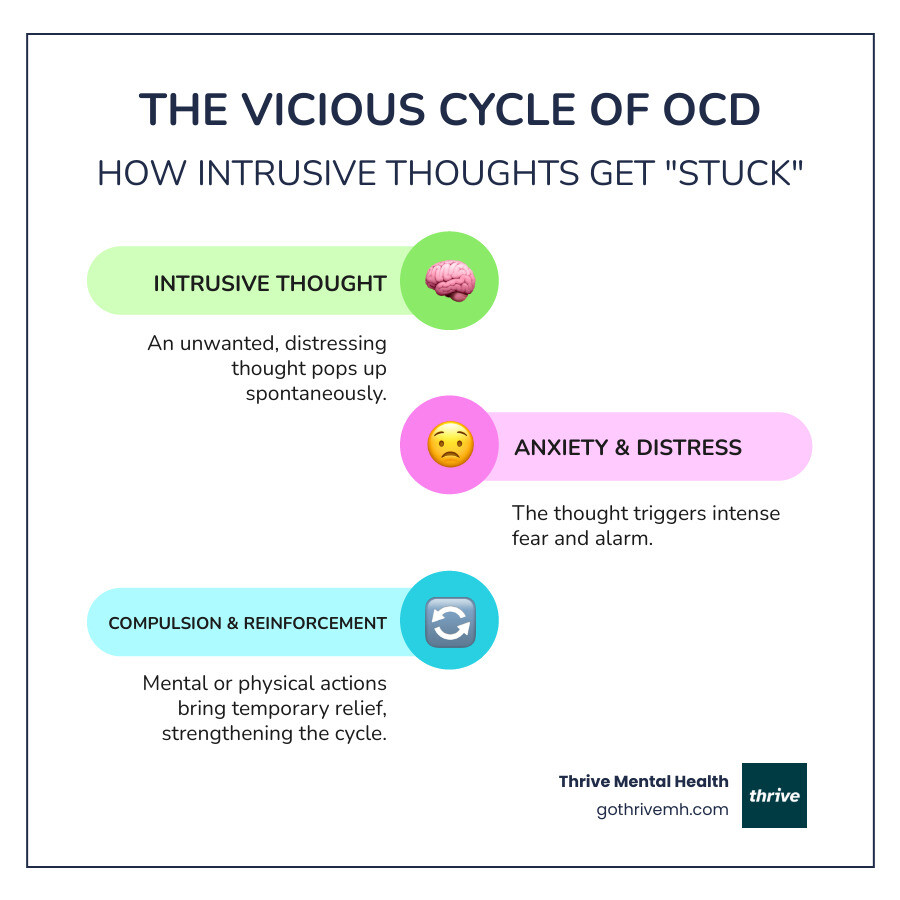Thoughts Gone Wild – A Guide to OCD Intrusive Thoughts

Intrusive Thoughts OCD: Your #1 Guide to Conquer
Why Your Brain Sends You “Junk Mail”
Intrusive thoughts ocd affects millions, presenting as unwanted, disturbing thoughts that feel impossible to shake. These thoughts aren’t a reflection of who you are; they’re mental “junk mail” your brain mistakenly flags as urgent.
Quick Answer for Intrusive Thoughts OCD:
- What they are: Unwanted, distressing thoughts that go against your values
- How common: Over 90% of people experience them, but only 2.3% develop OCD
- Key difference: People with OCD get “stuck” on these thoughts and perform compulsions to reduce anxiety
- Treatment: Exposure and Response Prevention (ERP) therapy is the gold standard
- Important: These thoughts don’t mean you’ll act on them or that you’re a bad person
Your brain’s alarm system is designed to protect you, but with OCD, it misfires. It treats random, meaningless thoughts as serious threats, making them “sticky”—the harder you try to push them away, the more they persist.
The OCD cycle is vicious: an unwanted thought triggers intense anxiety, leading to a compulsion for temporary relief. This relief reinforces the thought, making it return stronger. It’s not your fault; it’s how OCD hijacks the brain’s protective instincts.
I’m Anna Green, LMHC, LPC, Chief Clinical Officer at Thrive Mental Health. I’ve spent years helping people break free from the cycle of intrusive thoughts ocd using treatments like ERP. A key first step is understanding these thoughts are the opposite of your values, not hidden desires.

Easy intrusive thoughts ocd word list:
What Separates a Weird Thought from an OCD Intrusive Thought?
Most people (over 90%) experience intrusive thoughts—sudden, weird ideas like “what if I jumped?” or “what if I dropped the baby?” These are unwanted, spontaneous thoughts, images, or urges. For most, they’re meaningless mental static that quickly fades.
The crucial difference isn’t the thought, but your reaction. Without OCD, you might think “that was weird” and move on. With intrusive thoughts ocd, the thought becomes “sticky.” You attach great significance to it, viewing it as dangerous or a reflection of your character.
This “sticky mind” traps normal thoughts in a loop of analysis and worry. A 2014 research study found nearly 94% of students had intrusive thoughts, but only about 2.3% of people develop OCD. The difference is getting stuck in the cycle of distress. For more details, see our guide to OCD symptoms.
The Role of Obsessions and Compulsions
When intrusive thoughts become sticky, they transform into obsessions: persistent, unwanted thoughts causing significant anxiety. They feel urgent, threatening, and impossible to ignore, often involving fears of contamination, harming someone, or relationship doubts.
To cope, people develop compulsions—repetitive physical or mental acts to reduce distress. These can be visible (hand washing, checking) or mental (counting, seeking reassurance). Compulsions provide short-term relief, which tricks your brain into thinking the obsession was a real threat. Each compulsion reinforces the idea that the thought is dangerous, strengthening the cycle.
Invisible mental compulsions like mental checking, reassurance seeking, or rumination are just as powerful. Understanding this dynamic is key to grasping the full meaning of OCD and why “just ignoring it” fails.
What is ‘Pure O’ and Why Is It a Misnomer?
You may have heard of “Pure O” (Purely Obsessional) OCD, which describes intrusive thoughts ocd with no visible compulsions. However, “Pure O” is a misnomer. The compulsions are still there; they’re just mental and hidden.
These covert mental compulsions are just as exhausting as physical ones and include:
- Mental checking: Reviewing events to ensure you did nothing wrong.
- Reassurance seeking: Constantly asking for confirmation that fears aren’t real.
- Rumination: Getting trapped in “what if” scenarios.
- Thought suppression: Trying to push away “bad” thoughts.
These mental gymnastics keep the OCD cycle spinning. The person appears fine externally, but their mind is in overdrive. The OCD-UK website clarifies that these hidden compulsions are a core part of the disorder.
The Vicious Cycle: How Your Reaction to Intrusive Thoughts Fuels OCD
CALLOUT BOX: If you are having thoughts of harming yourself or others, or are in crisis, please call or text 988 for the Suicide & Crisis Lifeline. You are not alone.
In intrusive thoughts ocd, your brain’s fear network acts like a hypersensitive smoke detector. It misinterprets harmless mental “smoke” as a five-alarm fire, screaming “DANGER!” at random thoughts.
These thoughts are so painful because they attack what you value most. A loving parent might have thoughts of harming their child; a devout person might have blasphemous thoughts. The cruel irony is that the thoughts are upsetting precisely because they oppose your core values. A violent person wouldn’t be disturbed by a violent thought.
Reacting with fear, guilt, or disgust teaches your brain the thought is important. Your anxiety highlights the thought as “URGENT,” making your brain believe it’s a real danger. This leads to the short-term relief trap: you perform a compulsion to ease the anxiety. The temporary relief reinforces the compulsion, teaching your brain it “worked” and making the thought return with greater intensity.
Common Themes of Intrusive Thoughts in OCD
Intrusive thoughts ocd targets what matters most. Common themes include:
- Harm OCD: Fears of causing violence or injury to yourself or others, often through vivid, unwanted images.
- Relationship OCD (ROCD): Constant doubts about your relationship, such as “Do I really love my partner?” leading to analysis and reassurance seeking.
- Contamination OCD: An overwhelming fear of germs, disease, or feeling “contaminated,” which can be physical or mental.
- Sexual Intrusive Thoughts: Shame-inducing, taboo thoughts that contradict a person’s values and orientation (e.g., thoughts about children, family members).
- Religious/Scrupulosity OCD: Turns faith into torment, with obsessions about committing sins, blasphemy, or performing rituals incorrectly.
- Existential OCD: Getting stuck on unanswerable questions about reality, meaning, and existence, causing profound distress.
These themes target your values, like a bully exploiting your deepest insecurities.
Why You Can’t “Just Stop Thinking” About It
Being told to “just stop thinking about it” is unhelpful advice for intrusive thoughts ocd and can make things worse. This is the “pink elephant problem”: try not to think of a pink elephant, and that’s all you can picture. Trying to suppress a thought makes your brain focus on it.
Thought suppression failure occurs because to suppress a thought, part of your brain must monitor for it, which keeps the thought active. Research shows that thought suppression can actually make intrusive thoughts more frequent and distressing. It signals to your brain that the thought is dangerous.
Distraction offers only temporary relief. The real solution is to change your relationship with the thoughts, not eliminate them. As explored in How CBT Can Transform Negative Thought Patterns, recovery is about learning to coexist with mental static. The paradox is that the harder you fight, the stronger the thoughts become.
Reclaiming Your Mind: Gold-Standard Treatments for Intrusive Thoughts OCD

With intrusive thoughts ocd, it can feel like your mind has turned against you. But recovery is probable with the right treatment. The goal isn’t to eliminate intrusive thoughts—it’s to change your relationship with them, stripping them of their power so you can live by your values, not your fears. It’s like learning to recognize spam email and deleting it without analysis or panic.
Exposure and Response Prevention (ERP): The #1 Treatment
For intrusive thoughts ocd, Exposure and Response Prevention (ERP) is the gold-standard treatment. It directly targets the cycle of reaction to intrusive thoughts. ERP involves systematically facing thoughts that trigger obsessions (exposure) while resisting the urge to perform compulsions (response prevention).
For example, someone with harm OCD might intentionally bring on a distressing thought and sit with the anxiety without performing their usual mental rituals. Through a process called habituation, your brain gradually learns the thoughts aren’t dangerous, and the anxiety naturally decreases. We create an exposure hierarchy, starting with manageable challenges and working up. Learn more in our Quick Start Guide to Exposure and Response Prevention Therapy.
Cognitive Behavioral Therapy (CBT) and Other Supports
ERP works best within a broader Cognitive Behavioral Therapy (CBT) framework, which helps you identify cognitive distortions that fuel OCD. CBT teaches you that thoughts are not facts and helps you challenge the meaning you attach to them.
Other powerful tools include:
- Mindfulness skills: To observe thoughts without judgment.
- Acceptance and Commitment Therapy (ACT): To accept the presence of thoughts while committing to value-driven actions.
- Support groups: To connect with others who understand, providing validation and hope.
Explore more about The Benefits of CBT in Mental Health Treatment.
Flexible Treatment Options and Insurance Coverage
Thrive Mental Health offers flexible options like our Virtual Intensive Outpatient Program (VIOP) and Partial Hospitalization Programs (PHP). These structured programs offer more intensive care than weekly therapy, accelerating progress with expert guidance.
Our virtual programs are ideal for busy professionals, offering expert care from home with evening options. Insurance coverage shouldn’t be a barrier; we work with major providers like Cigna, Aetna, Florida Blue, and Optum.
Whether you’re in South Florida (like Miami, Fort Lauderdale, or West Palm Beach) or anywhere else in the state, our virtual programs make expert OCD treatment accessible. Recovery from intrusive thoughts ocd is possible, and you don’t have to do it alone.
Frequently Asked Questions about Intrusive Thoughts and OCD
(Note for developers: Implement JSON-LD FAQ schema for these questions to improve SERP visibility.)
Do intrusive thoughts mean I’m a bad person or that I’ll act on them?
Absolutely not. Intrusive thoughts in OCD are ego-dystonic, meaning they are the opposite of your values and desires. The intense distress they cause is proof that you are not your thoughts and will not act on them. People with intrusive thoughts ocd are often exceptionally moral and caring individuals horrified by the content of their thoughts.
Can you have intrusive thoughts without having OCD?
Yes. Over 90% of people have intrusive thoughts. The difference with intrusive thoughts ocd is not the thought itself, but the reaction. In OCD, the thought causes extreme distress, is misinterpreted as significant or dangerous, and leads to compulsions (mental or physical rituals) to reduce anxiety.
What is the fastest way to get rid of intrusive thoughts?
Paradoxically, the fastest way to reduce their power is to stop trying to get rid of them. Trying to suppress a thought (the “boomerang effect”) makes it stronger. The goal of therapy like ERP is to change your relationship with the thoughts—to accept their presence without engaging. This teaches your brain they aren’t a threat, and over time, they lose their power and fade into the background.
Take the Power Back From Your Thoughts
Thoughts are not facts. Your intrusive thoughts are mental noise—brain spam that landed in your priority inbox. Recovery from intrusive thoughts ocd isn’t about silencing your mind, but changing your relationship with your thoughts. It’s about seeing them as meaningless mental events that don’t require a response.
The cycle of compulsions can stop. You don’t have to keep feeding the OCD monster. You have the power to reclaim your mind and live by your values, not your fears.
With evidence-based treatments like ERP and CBT, recovery is not just a possibility; it’s a realistic expectation backed by science. Thrive Mental Health’s specialized programs offer targeted, intensive treatment for intrusive thoughts ocd. Whether you’re a busy professional or have struggled for years, our flexible programs are designed for you. Recovery is within reach.
Ready for support in Florida? Thrive offers virtual and hybrid IOP/PHP with evening options. Verify your insurance in 2 minutes (no obligation) → Start benefits check or call 561-203-6085. If you’re in crisis, call/text 988.
